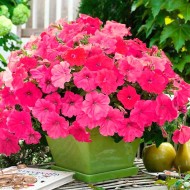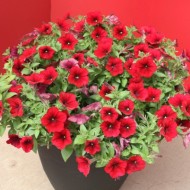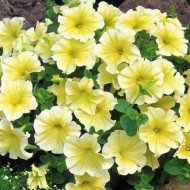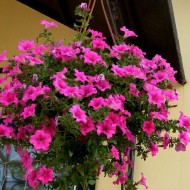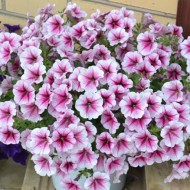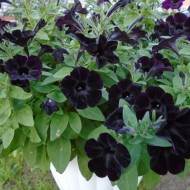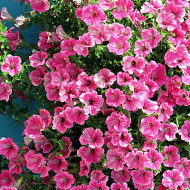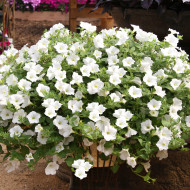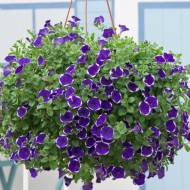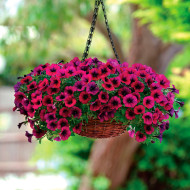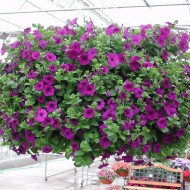A bright and blooming garden: the secrets of growing ampelous petunias
Content
Description of ampelous petunia
The name of the plant in translation from German means "hanging vase". The culture is called ampelous due to its structure: petunia stems are elastic, creeping. That is why the plant is grown in hanging vases and pots.

The length of the stems ranges from 40-130 cm. The leaves have a delicate, slightly velvety structure. This is due to the presence of barely noticeable pubescence on the leaves. Flowers ripen on the shoots. They resemble a bell in shape and reach from 4 to 11 cm in diameter.
The color scheme of the buds, as a rule, has two shades. The middle of the inflorescence is colored in a more saturated shade. The structure and color of petunia flowers mainly depend on the variety.
Ampel and cascade types of petunias are very similar in appearance, but they still have some differences:
- Stems. In the ampelous variety, the shoots are delicate, thin. In the cascade, they, on the contrary, are stronger and fleshy.
- Growing. For the first type of petunia, suspended containers are assumed. Cascading varieties may well be grown on supports. Due to its structure, cascading petunia often becomes an element of the garden composition.
- The size of the flowers. Flowers of different sizes are characteristic of the ampelous culture, while the cascading one forms approximately the same flowers.

The best varieties of ampelous petunias
Recently, the varietal variety of petunias has been replenished with hybrid varieties that have better resistance to fungal diseases and are easier to tolerate low temperatures. In addition, the flowering period of hybrids is much longer than that of “pure” varieties.
Velveteen
The crop is a good honey plant, which means the plant is great for gardens with a lack of pollinators. Corduroy is famous for its velvety flowers. During the flowering period, the bush is covered with rich pink buds. The cultivar usually produces rather small flowers. Gardeners often use a variety of growth stimulants.
Ekaterina
This hybrid variety forms flowers, the diameter of which reaches 6–8 cm. The color of the inflorescences is rather unusual - salmon. The variety is considered one of the best for creating a flower arrangement.
Easy Wave
A hybrid variety, the stems of which grow up to a meter in length. The flowers are bright red.
Avalanche
This variety consists of a whole series of varieties. Petunia Avalanche is characterized by a long flowering period and resistance to all sorts of pests.
Mashenka
This hybrid variety is renowned for its dense flowering. The plant is characterized by medium-sized purple flowers.
Opera Supreme
The culture is characterized by long shoots that reach about 130 cm in length. The flowers are lilac, medium-sized.Opera Supreme is undemanding to care for and adapts to any conditions.
- Velveteen
- Ekaterina
- Easy Wave
- Avalanche
- Mashenka
- Opera Supreme
Black velvet
This hybrid variety is in demand due to its unusual black flowers. Their size reaches 7-9 cm in diameter.
Svetlana
Petunia stems grow up to a meter long. The flowers have a characteristic wavy structure and pink color.
The Snow Queen
The length of the shoots reaches 70 cm. The bush is covered with snow-white flowers, similar to bells.
Surfinia
The variety includes a whole series of petunias of various colors. Surfinia flowers are large, have red, purple and blue shades.
Shock Wave
Super cascading petunia, which is famous for its double flowers. The color of the buds is predominantly white.
Explorer
The color range of the variety includes about 10 shades. The flowers are quite large and the stems are powerful.
- Black velvet
- Svetlana
- The Snow Queen
- Surfinia
- Shock Wave
- Explorer
Video "Rules for sowing ampel petunias"
This video tells about the peculiarities of sowing seeds of an ornamental culture.
Features of growing ampel petunias
Despite the fact that petunia is an unpretentious plant, compliance with some growing rules is still considered mandatory.
When to plant seedlings
The timing of planting petunias for seedlings directly depends on the place of further cultivation:
- Open ground. Seeds are sown from early to mid-March. In early summer, the seedlings are transplanted into the soil.
- Balcony. Mid-February. They are transplanted into pots in May.
- Cache-pot. Early February. Seedlings are transplanted in early May.
Sowing seeds
Gardeners recommend purchasing pelleted seeds. They are larger than usual, and this significantly increases the chances of germination.
Plastic containers are often used to grow seedlings. A drainage layer is certainly placed on the bottom, which will prevent moisture stagnation.
The containers are filled with the substrate so that about 3 cm remains to the edge. The seeds are evenly distributed over the surface of the soil, without sprinkling on top. The containers are covered with cling film.

Seedling care
The optimum temperature for growing seedlings is 25 ° C. Until the first shoots appear, you cannot water or spray the seeds. When the sprouts have appeared, the containers with the seedlings must be rearranged on a well-lit windowsill. The temperature in this case should not exceed 20 ° C. It is recommended to moisten the soil through regular spraying.
To prevent the development of fungal diseases, the soil can be spilled with a manganese solution. The cling film should remain on the plastic containers until a few strong leaves have formed.
In the evening, additional lighting is recommended for seedlings. A month later, the first feeding should be done. Further, it is necessary to feed the petunia every 14 days. It is better to use complex mineral compositions as a fertilizer.
Disembarkation to a permanent place
It is recommended to plant the plant on the south side. This applies to both open areas and balconies. Considering that the root system of petunia is quite branchy, for one bush you should pick up a pot with a volume of 7-12 liters. It is recommended to plant a culture one by one in a pots. In this case, the plant will feel spacious.
Petunia should be transplanted into open ground in the evening. It is worth observing an interval of 35 cm between seedlings.
After the planting procedure, the plant should be watered and mulched abundantly. Thus, the seedlings will be reliably protected from adverse weather conditions.
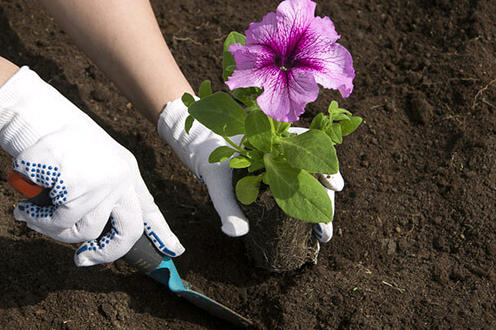
Prevention of diseases and pests
The most common cultural diseases are:
- brown spotting;
- blackleg;
- gray rot.
The main pests of petunias are aphids, mites and slugs. Failure to comply with the irrigation regime, deficiency of sunlight and nutrients in the soil leads to the occurrence of fungal diseases.
To prevent the appearance of a variety of diseases and their pathogens, it is recommended to follow some rules:
- Maintain the spacing between seedlings.
- Arrange moderate regular watering.
- Take care of enough sunlight.
- Feed the crop regularly.
- Remove dry inflorescences, leaves, shoots in a timely manner.

Growing problems and ways to solve them
Often, during the cultivation of petunias, troubles arise in the form of slow growth, lack of flowering. In this case, you should refer to the recommendations of experienced summer residents:
- Does not grow in breadth. The reason, most likely, is non-observance of the temperature regime. As a solution, pinching of the upper shoots can be applied. As a result, the culture will begin to grow in breadth.
- Does not bloom. Lack or insufficient flowering is associated with a lack of nutrients and light or too small a pot. To cope with the problem, you should organize a regular feeding regime, provide the bushes with sunlight and pick up a spacious pot.
In the event that it is not possible to transplant the plant into a spacious container, you can resort to pruning the roots. To do this, the petunia is carefully removed from the soil, the roots are slightly shortened and placed in the same pot.
Petunia is one of the most popular plants. This garden beauty will make any summer cottage special. The culture is unpretentious in cultivation, so it will be an excellent option for almost any region of Russia.

